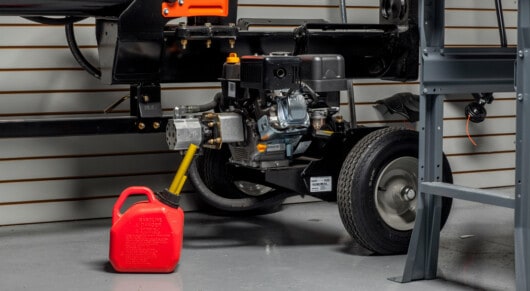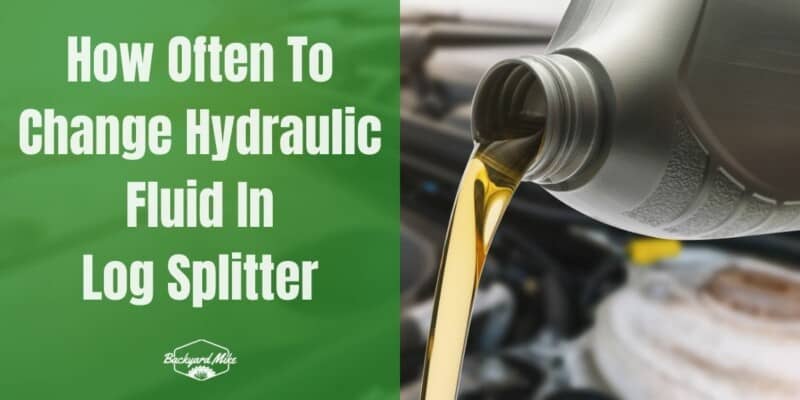Do you own a hydraulic log splitter, but don’t know how often to change the hydraulic fluid in it? If so, then you’re definitely in the right place.
Changing hydraulic fluid in log splitter is something that every hydraulic log splitter owner must do. Many manufacturers advise that you must change your splitter’s hydraulic fluid after every 50 hours. If the hydraulic fluid is of high quality, this will can easily give you around 150 hours of log splitter operation. This will largely depend on the type of logs you’re splitting and how hard it is to split.
In this article, you’ll get to know all about hydraulic fluid in log splitters, what type of hydraulic oil should be used in a hydraulic log splitter, how often should you change hydraulic fluid in a log splitter, how to change the hydraulic fluid in a log splitter, and more. Continue reading to get all the answers that you’re looking for.
What is hydraulic fluid?
Hydraulic fluid is the channel that transfers power within hydraulic machinery. The ram mechanism on a hydraulic log splitters will require hydraulic fluid inside to be able to provide the needed power for splitting logs with ease. The hydraulic fluid is also needed for forklifts, tractors, aircraft, ships, cruises, and almost every other industry. It’s essential that the hydraulic fluid carries the right properties for the operating conditions. It needs to be thermally stable, non-corrosive, fire-resistant, and carry a constant viscosity while being long life.
Hydraulic fluid for a log splitter will act as the lubricant for improving the performance of the system. They’re made from different types of ingredients including mineral oil, ethers, ester, glycol, and silicone. Log splitter hydraulic fluids can be classified into the following types –
Flame-retardant
Hydraulic fluid can easily burn when it is exposed to high-temperature conditions. If the fluid burns, it’ll leak and affect the capabilities of the log splitter. It can end up damaging the entire hydraulic system. Hence, to reduce fire risks because of burning, log splitter owners often use a flame-retardant hydraulic fluid.
Wear-resistant
Wear-resistant hydraulic fluid is the recommended hydraulic fluid for pressure, high-temperature environments. This kind of fuel protects the hydraulic pump and other hydraulics system components from early wear and tear using a grill or screen.
Eco-friendly
This type of hydraulic fluid is environmentally friendly and best for use in farms, forests, and preserves. This fluid comes with a biodegradable base, which means it’ll naturally degrade in water or soil in case of a spill.
Additives used in a hydraulic log splitter
Most hydraulic wood splitter users include these things to enhance the system’s performance.
- Anti-wear additives having anti-wear properties for extending engine life
- Anti-foaming will reduce foam because of detergents
- Anti-rust protects the hydraulic components by having a special coat against oxygen contact
- Anti-oxidant for improving the life of the system and avoiding regular oil changes
What type of hydraulic oil should you use in a hydraulic log splitter?
Generally, the manufacturer of the log splitter mentions a recommended oil available within the user manual. However, you must have a basic understanding of what you’re looking at when buying hydraulic fluid. Viscosity is a term that you must be aware of, as it’s used for describing the fluid’s resistance to flow. Higher viscosity will mean a much longer timeframe to pass through the orifice. It means that it’s thicker and harder to compress, whereas low viscosity will indicate a thinner and more fluid oil.
The weather will also have an effect on oil viscosity. It makes a low-index viscosity thicker until it has warmed up. The ISO number displayed on the hydraulic fluid will be the viscosity grade. You need to choose a thinner option for cold weather as well as a mid-range option for high heat.

There are hydraulic fluid options specially formulated for improving the performance of electric log splitters. Only virgin oils are used for blending this fluid. This means it can last much longer without having any degradation compared to cheaper oils. The latter are generally blended from recycled oil. The hydraulic fluid comes designed for meeting the requirements of today’s log splitters.
When replacing old fluid with high-quality hydraulic fluid, the log splitter sees a performance increase of up to 30%. It’ll meet the essential properties needed by hydraulic log splitters.
How often to change hydraulic fluid in log splitters?
A lot of hydraulic log splitter manufacturers advise that you must change your hydraulic fluid after every 50 hours. However, if the hydraulic fluid used is of high quality, it can give you around 150 hours of log=splitting operation. It’ll largely depend on the type of log to split and how hard the splitting process is. If the hydraulic log splitter is kept clean and the hydraulic fluid used is clear, the fluid is fine to continue using until low.
But how will you know when to top up the fluid? If you know your way around log splitters, you’ll know it can be tricky to read a log splitter dipstick. This is mostly because of how clear the hydraulic fluid is. However, there are certain tricks to learn when you should consider topping up your fluid without having to open up the machine.
In case the hydraulic fluid level is low, you’ve probably already experienced a drop in performance. Logs that your hydraulic log splitter once breezed through like butter to a knife will start whirring and being pushed to their limits. Raise the front of the splitter on a block of wood or something similar. It pushes the hydraulic fluid to the back of the log splitter. Moreover, you’ll see an instant boost in performance levels. This will tell you that the hydraulic fluid levels are low.
How to change the hydraulic fluid in your hydraulic log splitter?
All hydraulic log splitter users must learn how to maintain a powerful machine. Part of this will be in knowing when and how to change the hydraulic fluid. Here is how you should change the hydraulic fluid in your log splitter.
1. Place a fluid tray or any container under the hydraulic tank
The container needs to be big enough that it can accommodate 3 gallons of hydraulic fluid from the reservoir tank.
2. Remove the suction hose from the hydraulic tank
Check the owner’s manual for the location of the tank and how you can remove the hose. The owner manual will have the engine’s specific model’s specs and parts. You should then choose to remove the splitter’s drain plug.
3. Loosen the inlet filter
Now, clean the oil filter by using a small rag and penetrating oil.
4. Allow the fluid to drain into the container
Once the hydraulic fluid tank is empty, reinstall the hose, pump, filter, and cylinder. After that, you should tighten the clamps of the hose. Most reservoirs don’t completely drain, so you should slightly move the tank.
5. Determine the hydraulic fluid levels with a dipstick
Fill the hydraulic tank with hydraulic fluid, but remember not to overfill. Consider how much hydraulic fluid will you be using. How will you know that the tank has the proper amount? Check the range marker present on the dipstick. The tank needs to be filled with fresh hydraulic fluid from that level.

6. Prime the log splitter pump
First, you’ll need to disconnect the spark plug. You should place the recoil starter, hold it, and rip it ten times. Afterward, you should reconnect the spark plug and then restart the engine.
7. Engage the log splitter wedge
Place the splitter wedge to its farthest position from the beam and then, retract it to place it in the starting position.
8. Self-bleed the hydraulic log splitter
Move the control handle or pull cord to the back or front of the tank. Do it 10-12 times to remove any trapped air from the hydraulic log splitter.
Conclusion
Thank you for reading. Hopefully, now you know a lot more about hydraulic fluid in log splitters, what type of hydraulic oil should be used in a hydraulic log splitter, how often should you change hydraulic fluid in a log splitter, how to change the hydraulic fluid in log splitter, and more. Changing the hydraulic fluid in a log splitter is something that every hydraulic log splitter owner must do. Many manufacturers advise that you must change your splitter’s hydraulic fluid after every 50 hours. If the hydraulic fluid is of high-quality, this will can easily give you around 150 hours of log splitter operation. This will largely depend on the type of logs you’re splitting and how hard it is to split.


